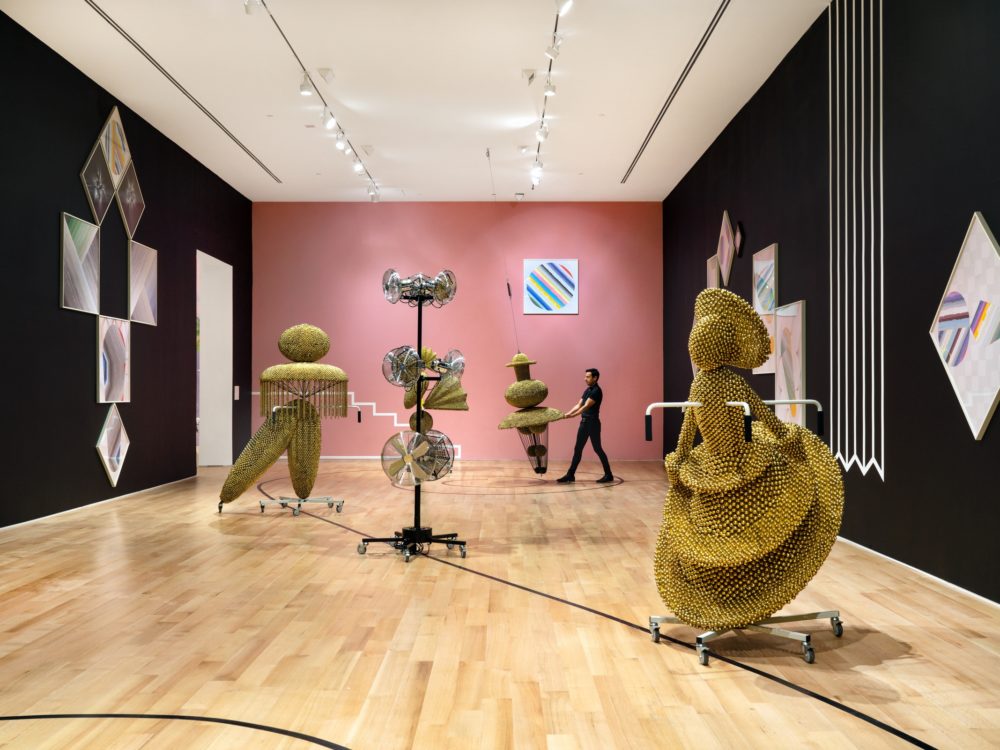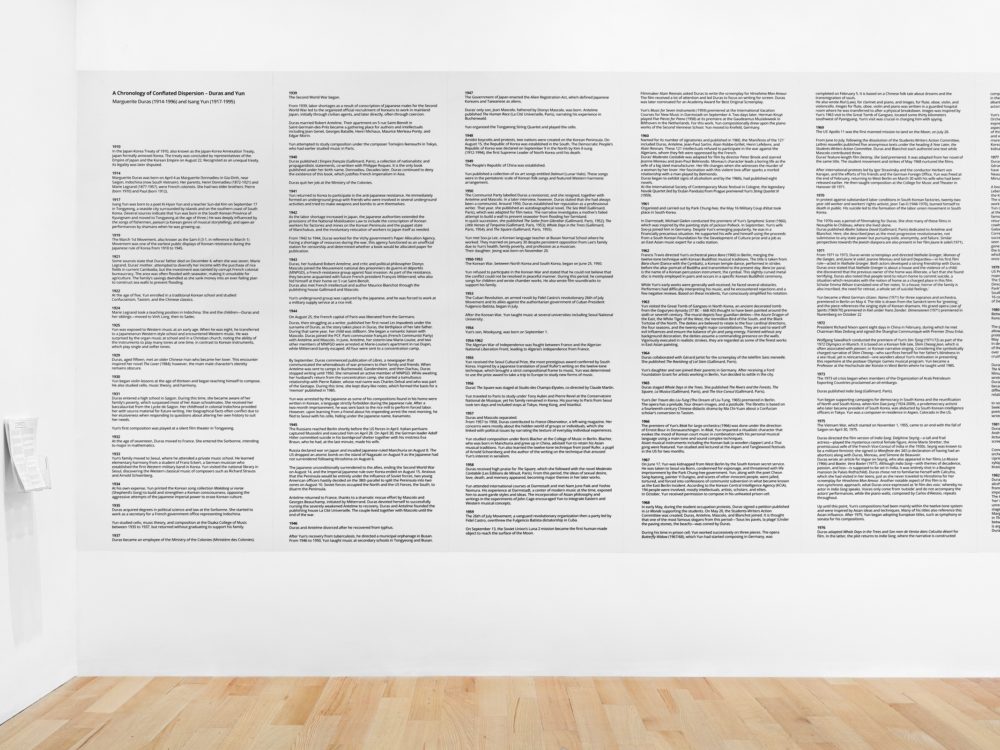HAEGUE YANG
In the Cone of Uncertainty
In the Cone of Uncertainty foregrounds Haegue Yang’s (b. 1971, Seoul) consistent curiosity about the world and tireless experimentation with materializing the complexity of identities in flux. Living between Seoul and Berlin, Yang employs industrially produced quotidian items, digital processes, and labor-intensive craft techniques. She mobilizes and enmeshes complex, often personal, histories and realities vis-à-vis sensual and immersive works by interweaving narrative with form. Often evoking performative, sonic and atmospheric perceptions with heat, wind and chiming bells, Yang’s environments appear familiar, yet engender bewildering experiences of time and place.
The exhibition presents a selection of Yang’s oeuvre spanning the last decade – including window blind installations, anthropomorphic sculptures, light sculptures, and mural-like graphic wallpaper – taking its title from an expression of the South Florida vernacular, that describes the predicted path of hurricanes. Alluding to our eagerness and desperation to track the unstable and ever-evolving future, this exhibition addresses current anxieties about climate change, overpopulation and resource scarcity. Framing this discourse within a broader consideration of movement, displacement and migration, the exhibition contextualizes contemporary concerns through a trans-historical and philosophical meditation of the self.
Given its location in Miami Beach, The Bass is a particularly resonant site to present Yang’s work, considering that over fifty percent[1] of the population in Miami-Dade County is born outside of the United States, and it is a geographical and metaphorical gateway to Latin America. Yang has been commissioned by the museum to conceive a site-specific wallpaper in the staircase that connects the exhibition spaces across The Bass’ two floors. This wallpaper will be applied to both transparent and opaque surfaces to accompany the ascending and descending path of visitors within the exhibition. Informed by research about Miami Beach’s climatically-precarious setting, the wallpaper, titled Coordinates of Speculative Solidarity (2019), will play with meteorological infographics and diagrams as vehicles for abstraction. Interested in how severe weather creates unusual access to negotiations of belonging and community, as well as the human urge to predict catastrophic circumstances, the work reflects a geographic commonality that unconsciously binds people together through a shared determination to face a challenge and react in solidarity.
Yang’s exhibition encompasses galleries on both the first and second floors of the museum and exemplifies an array of Yang’s formally, conceptually ambitious and rigorous body of work. Considered an important ‘Light Sculpture’ work and one of the last made in the series, Strange Fruit (2012-13) occupies one of the first spaces in the exhibition. The group of anthropomorphic sculptures take their title from Jewish-American Abel Meeropol’s poem famously vocalized by Billie Holiday in 1939. Hanging string lights dangling from metal clothing racks intertwined with colorfully painted papier-mâché bowls and hands that hold plants resonate with the poem’s subject matter. The work reflects a recurring interest within Yang’s practice, illuminating unlikely, less-known connections throughout history and elucidating asymmetrical relationships among figures of the past. In the story of Strange Fruit, the point of interest is in a poem about the horrors and tragedy of lynching of African-Americans in the American South born from the empathies of a Jewish man and member of the Communist party. Yang’s interests are filtered through different geopolitical spheres with a keen concentration in collapsing time and place, unlike today’s compartmentalized diasporic studies.
Central to In the Cone of Uncertainty is the daring juxtaposition of two major large-scale installations made of venetian blinds. Yearning Melancholy Red and Red Broken Mountainous Labyrinth are similar in that they are both from 2008, a year of significant development for Yang, and their use of the color red: one consists of red blinds, while the other features white blinds colored by red light. With its labyrinthine structure, Red Broken Mountainous Labyrinth bears a story of the chance encounter between Korean revolutionary Kim San (1905-1938) and American journalist Nym Wales (1907-1997), without which a chapter of Korean history would not survive to this day. Yearning Melancholy Red references the seemingly apolitical childhood of French writer and filmmaker Marguerite Duras (1914-1996). While living in French Indochina (present-day Cambodia, Vietnam, and Laos), Duras and her family experienced a type of double isolation in material and moral poverty, by neither belonging to the native communities nor to the French colonizers, embodying the potentiality for her later political engagement. Despite their divergent subject matter, both works continue to envelop an interest in viewing histories from different perspectives and the unexpected connections that arise. By staging the two works together, what remains is Yang’s compelling constellation of blinds, choreographed moving lights, paradoxical pairings of sensorial devices – fans and infrared heaters – and our physical presence in an intensely charged field of unspoken narratives.
A third space of the exhibition will feature work from Yang’s signature ‘Sonic Sculpture’ series titled, Boxing Ballet (2013/2015). The work offers Yang’s translation of Oskar Schlemmmer’s Triadic Ballet (1922), transforming the historical lineage of time-based performance into spatial, sculptural and sensorial abstraction. Through elements of movement and sound, Yang develops an installation with a relationship to the Western Avant-Garde, investigating their understanding in the human body, movement and figuration.
Observing hidden structures to reimagine a possible community, Yang addresses themes that recur in her works such as migration, diasporas and history writing. Works presented in In the Cone of Uncertainty offer a substantial view into Yang’s rich artistic language, including her use of bodily experience as a means of evoking history and memory.
Haegue Yang lives and works in Berlin, Germany and Seoul, South Korea. She is a Professor at the Staedelschule in Frankfurt am Main. Yang has participated in major international exhibitions including the 21st Biennale of Sydney (2018), La Biennale de Montréal (2016), the 12th Sharjah Biennial (2015), the 9th Taipei Biennial (2014), dOCUMENTA (13) in Kassel (2012) and the 53rd Venice Biennale (2009) as the South Korean representative.
Recipient of the 2018 Wolfgang Hahn Prize, she held a survey exhibition titled ETA at the Museum Ludwig in Cologne in the same year, which displayed over 120 works of Yang from 1994-2018. Her recent solo exhibitions include Tracing Movement, South London Gallery (2019); Chronotopic Traverses, La Panacée-MoCo, Montpellier (2018); Tightrope Walking and Its Wordless Shadow, La Triennale di Milano (2018); Triple Vita Nestings, Govett-Brewster Art Gallery, New Plymouth, which travelled from the Institute of Modern Art, Brisbane (2018); VIP’s Union, Kunsthaus Graz (2017); Silo of Silence – Clicked Core, KINDL – Centre for Contemporary Art, Berlin (2017); Lingering Nous, Centre Pompidou, Paris (2016); Quasi-Pagan Serial, Hamburger Kunsthalle (2016); Come Shower or Shine, It Is Equally Blissful, Ullens Center for Contemporary Art, Beijing (2015); and Shooting the Elephant 象 Thinking the Elephant, Leeum, Samsung Museum of Art, Seoul (2015). Forthcoming projects include the Museum of Modern Art (October 2019), Tate St. Ives (May 2020) and Art Gallery of Ontario in Toronto (2020).
Yang’s work is included in permanent collections such as the Museum of Modern Art, New York, USA; M+, Hong Kong, China; National Museum of Modern and Contemporary Art, South Korea; Tate Modern, London, UK; The Solomon R. Guggenheim Museum, New York, USA; and The Walker Art Center, Minneapolis, USA. Her work has been the subject of numerous monographs, such as Haegue Yang: Anthology 2006–2018: Tightrope Walking and Its Wordless Shadow (2019); Haegue Yang: ETA 1994–2018 (2018); Haegue Yang – VIP’s Union (2017); and Haegue Yang: Family of Equivocations (2013).
[1] United States Census Bureau. (2017). Foreign born persons, percent, 2013-2017. Retrieved from https://www.census.gov/quickfacts/fact/table/miamidadecountyflorida#
Image: Haegue Yang, Boxing Ballet, 2013/2015. Leeum, Samsung Museum of Art. Installation view of Journal of Echomimetic Motions, Bergen Kunsthall, Norway, 2013. Photo: Thor Brødreskift

















